WHEN WAR
BEGAN IN
1688, FRANCE
UNLEASHED A
PLAGUE OF
STATE-SANCTIONED
PIRATES UPON
THE ENGLISH
CHANNEL. No
merchant
vessel along
Europe’s
northern
shores was
safe from
these French
privateers
or
“corsairs”.
To be sure,
it was
dangerous
business
being a
corsair but
that did not
discourage a
horde of
French youth
from taking
to the
seas.
When René
Duguay-Trouin
left his
home port of
Saint-Malo
in 1689
aboard an
18-gun
corsair
frigate, the
Trinity,
the
sixteen-year-old
had little
knowledge of
the life he
had embarked
upon. Sea
sickness,
storms, and
shipwreck
welcomed the
young sailor
to the sea.
Then came
battle.
Cruising the
Channel, the
Trinity
crossed
paths with a
Dutch ship
of equal
strength.
The two
vessels
immediately
closed upon
each other
and boarding
parties were
made ready.
Armed with
swords,
daggers,
blunderbusses
and pistols,
the crew of
corsairs
prepared for
their chance
to jump onto
the Dutch
ship.
Initially
enthusiastic,
Duguay-Trouin
turned
cautious
when he
witnessed
his
boatswain
misjudge the
distance,
fall, and
was crushed
between the
colliding
vessels. So
violent was
the
boatswain’s
death, that
Duguay-Trouin’s
clothing was
splattered
with the
poor
sailor’s
brains:
“This object
stopped me
all the more
as I
reflected
that, not
having sea
legs like
him, it was
morally
impossible
for me to
avoid such a
dreadful
kind of
death.” Yet
the young
sailor with
sword in
hand boarded
and received
boarders
while part
of his ship
was ablaze.
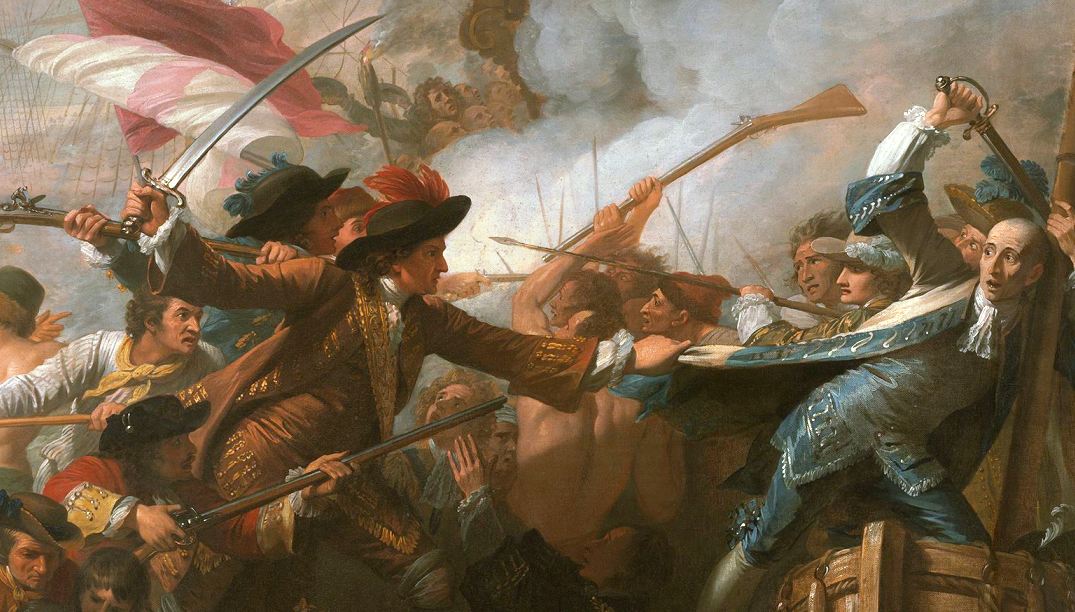
Hand to hand
fighting at
the Naval
Battle of La
Hogue, 1692
(Benjamin
West)
When
sixteen-year-old
Duguay-Trouin
returned
victorious
to his home
of
Saint-Malo,
his
experience
did not
dissuade him
from a
pirate’s
life: “This
campaign
which had
made me
consider all
the horrors
of the
shipwreck,
and those of
a bloody
collision
did not put
me off.”
This was the
French
privateer's
hardiness
and
fearlessness
that the
English and
Dutch had to
contend
with.
Hundreds of
ships fell
prey to the
corsairs and
were towed
triumphantly
into the
protected
harbour of
Saint-Malo.
The port’s
taverns and
brothels
became rich
from the
ill-gotten
gains of
their
privateer
cliental.
Nestled
behind its
tall walls
and the
newly-improved
harbour
island
forts,
Saint-Malo
was ideally
situated for
corsairs to
pounce on
any vessel
entering the
English
Channel from
the
Atlantic, or
skip across
to the Irish
Sea to reek
havoc on
commerce
there.
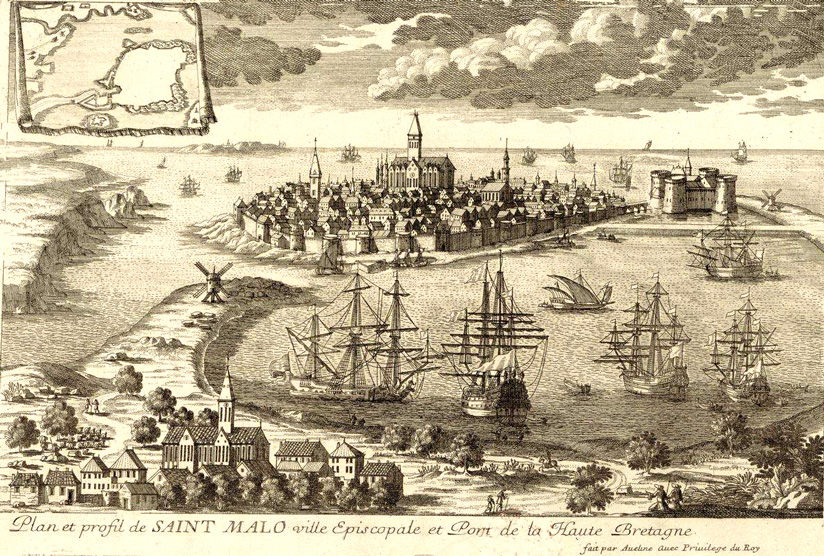
Plan and
profile of
Saint Malo.
(published
1700)
England’s
merchants
clamoured
for action
against the
“nest of
wasps” at
Saint-Malo.
Far from
ruling the
waves,
England
lacked the
strength to
contend with
the corsair
threat on
the high
seas or in
the waters
close to
home.
Looking for
a solution,
a 17th
century
“nuclear
option” was
concocted.
Like the
Manhattan
project of
WW2, the
project was
cloaked in
secrecy.
At the wharf
of the Tower
of London a
strange
vessel was
docked.
Black sails
were mounted
on its
masts.
Hundreds of
barrels were
carefully
rolled out
on board.
Wagons
filled with
explosive
materiel and
projectiles
circled from
the tower to
the dark,
port-less
ship. The
English were
building a
floating
bomb that
the world
had never
seen
before. Its
sole purpose
was the
complete
annihilation
of
Saint-Malo.
It was a
Hellburner.
It was an
Infernal
Machine.
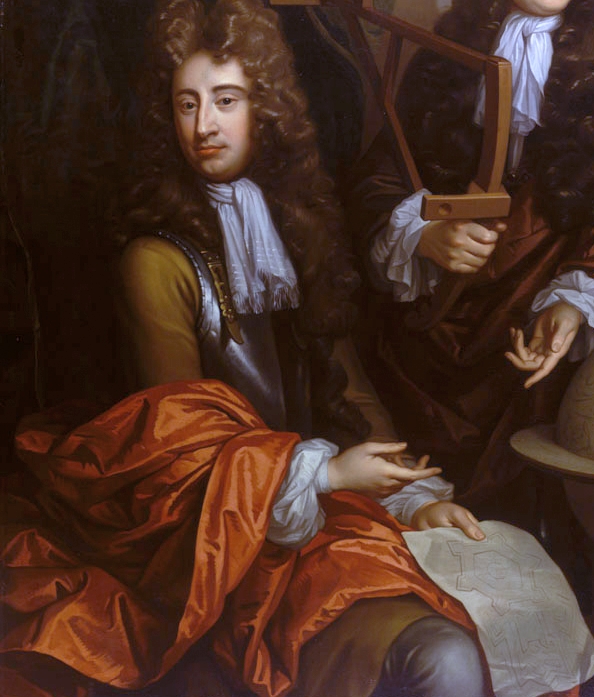
Naval
Ordnance
Engineer
Thomas
Phillips in
1693 just
prior to
setting sail
for Saint
Malo
(National
Maritime
Museum)
Its inventor
was a French
Huguenot by
the name
Fournier who
had fled to
England from
religious
persecution
in his home
country.
Fournier’s
Infernal
Machine was
not a
creature of
half-measures.
Making
Fournier’s
plan come to
life was
navy
ordinance
engineer
Thomas
Phillips;
and it would
be Phillips
who would
light the
fuse. The
300-ton
galleon was
packed with
destructive
material to
cause a hell
of
projectiles
to rain down
upon the
French.
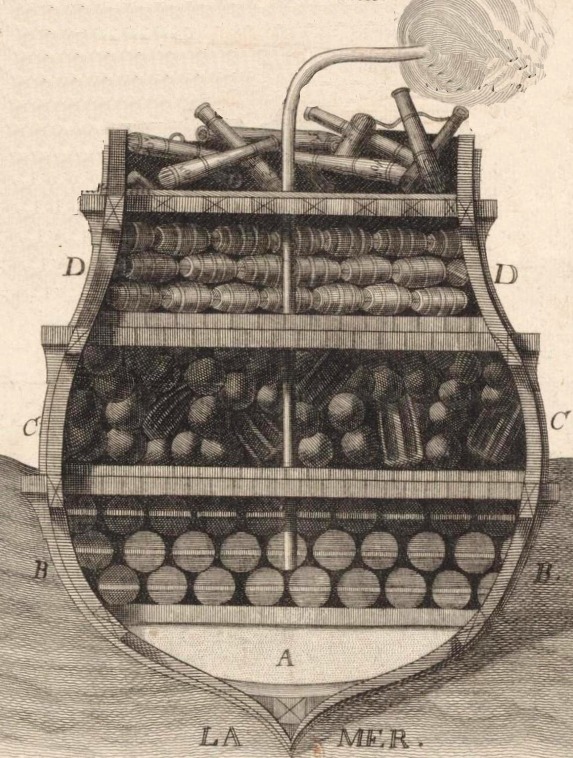
The Infernal
Machine
(published
1697). Part
of the ship
was studied
by French
engineers
who made
this
drawing.
At the base
of its haul
was a layer
of sand to
soak up any
moisture and
add ballast.
(A on the
above
illustration)
The sand was
covered with
masonry on
which over a
100 barrels
of gunpowder
were laid.(B)
Separated by
two feet of
masonry was
the next
level
containing
six hundred
tarred-linen
"carcasses
and chests
filled with
grenades,
cannon-balls,
iron chains,
loaded
firearms,
large pieces
of metal
wrapped up
in
tarpaulins,
and other
destructive
missiles.”(C)
When the
ship
exploded the
carcasses
would be
launched
into the air
and land on
houses or
ships
catching
them on
fire. The
grenades and
loaded
firearms
would then
explode or
fire off
randomly
discouraging
the French
from
fighting the
fire caused
by the
carcass
(learn more
about
carcasses
here).
Fifty
barrels
filled with
projectiles
and
fireworks-like
missiles
composed the
next
level.(D)
On the deck
was a pile
of loaded
cannon
barrels,
packed with
gun powder
and ball to
explode. As
an
additional
measure if
the cannon
barrels fell
into enemy
hands
intact, they
were made
useless by
knocking off
their
trunnions.
Without
trunnions,
the barrels
could not be
mounted on a
cannon
carriage.
Along with
the cannons
were mortars
loaded with
fused
exploding
shells.
To make the
ship explode
several
holes were
drilled from
the top deck
down to the
powder
barrels
below and
quick match
was laid.
There were
a number of
fuses, not
just one as
the
illustration
above
suggests.
Crew member
had to light
the matches,
scurry off
the ship to
a waiting
boat and
then row
like mad.
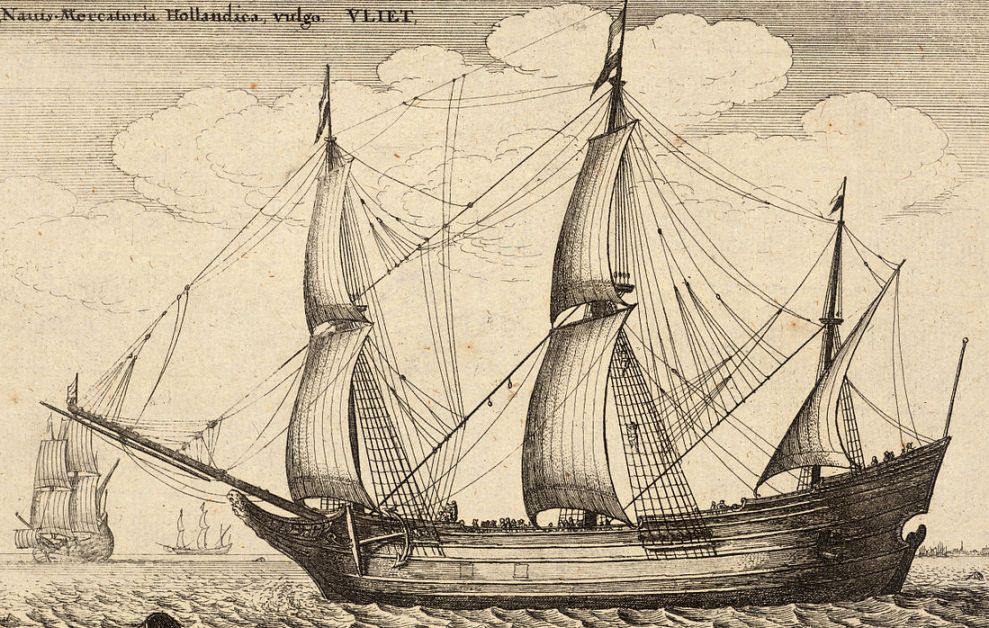
Dutch Flyte
Ship
(published
1677).
Similar to
the earlier
galleon in
cargo space
but faster
and with a
shallower
draft. The
Infernal
looked
like this
ship.
The
Infernal
had a
shallow
draft to
allow it to
pass through
shallow
waters and
get close to
Saint-Malo’s
fortification
where the
garrison
powder
magazine was
located.
That way
when the
infernal
machine
blew, the
French
powder
magazine
would feed
the
explosion
and bring
hell to the
entire nest
of pirates.
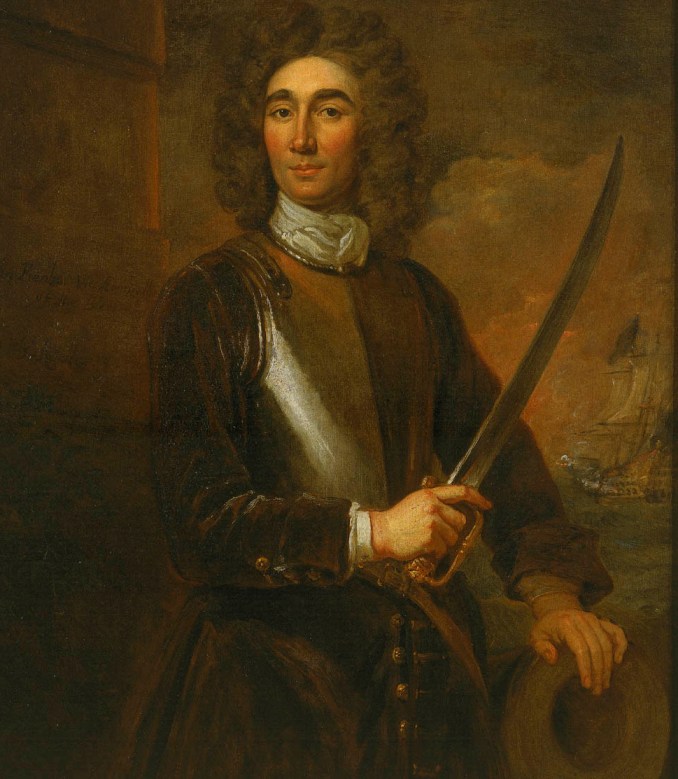
Captain John
Benbow, 1701
by Godfrey
Kneeler
(National
Maritime
Museum)
Benbow was
one of the
most
determined
officers in
the Royal
Navy in the
war.
In his last
battle he
led his crew
even after
being
wounded in
the leg with
chain-shot.
On November
13th, 1693 a
fleet of
twelve
warships,
twelve
brigantines,
four bomb
vessels
armed with
mortars for
shelling,
and the
Infernal set
sail for
Saint-Malo
under the
command of
the gallant
Captain John
Benbow.
Benbow had
oversaw the
infernal
ship project
and was keen
to see the
results of
the
enterprise.
However
Benbow’s
objective
was destroy
Saint-Malo
and the
Infernal
was only
weapon in
his
arsenal.
On the
afternoon of
November
16th, the
majority of
the fleet
drove
towards
Saint-Malo
on a strong
wind from
the north
riding a
great swell
and strong
tide. For
hours the
Royal Navy
crews
struggled in
the swirling
and
treacherous
waters to
position
their
vessels to
bombard the
city. It was
not until 10
o’clock at
night that
they were
able to
moor. From
that time
until 4
o’clock in
the morning
the fleet
bombarded
Saint-Malo,
lobbing
mortar
shells and
flaming
metal-banded
carcasses
over the
city's
walls.
With the
tide going
out, the
fleet had to
warp out of
the bay or
risk being
grounded on
the sand
bars that
surrounded
Saint-Malo.
The pattern
of
bombardment
continued
for the next
two days,
with the
bomb vessels
firing
hundreds of
bombs and
carcasses
into the
city.

The
navigation
around Saint
Malo. The
tan areas
are the sand
bars that
appear when
the tide is
out. The
English
needed to
come in with
the tide to
get close
enough to
bomb
Saint-Malo.
With the
arsenals of
the bomb
vessels
almost
expended,
the
Infernal
was called
forward on
the evening
of November
19th
. As a
diversion,
the fleet
dispatched a
landing
party to
overwhelm a
small
garrison and
burn a
convent on a
nearby
island.
Masked by
this flaming
spectacle on
the horizon,
the
Infernal,
with its
black sails
unfurled,
moved in.
On board was
Engineer
Phillips and
a skeleton
crew to
navigate the
ship through
the many
rocks and
shoals
littering
the approach
to the walls
of
Saint-Malo’s
old
stone-towered
citadel.
Under the
cover of
night the
Infernal
sailed
closer and
closer to
its
destination.
Just when
the ship was
almost in
place the
wind
suddenly
veered,
driving the
Infernal
out and onto
a rock.
Several
attempts
were made to
clear the
vessel from
the rock but
all were in
vain.
Phillips
soon
discovered
the haul had
been
punctured
and water
was leaking
into the
gunpowder
hold. With
little
options,
Phillips lit
the fuses
and he and
his crew
made their
escape.
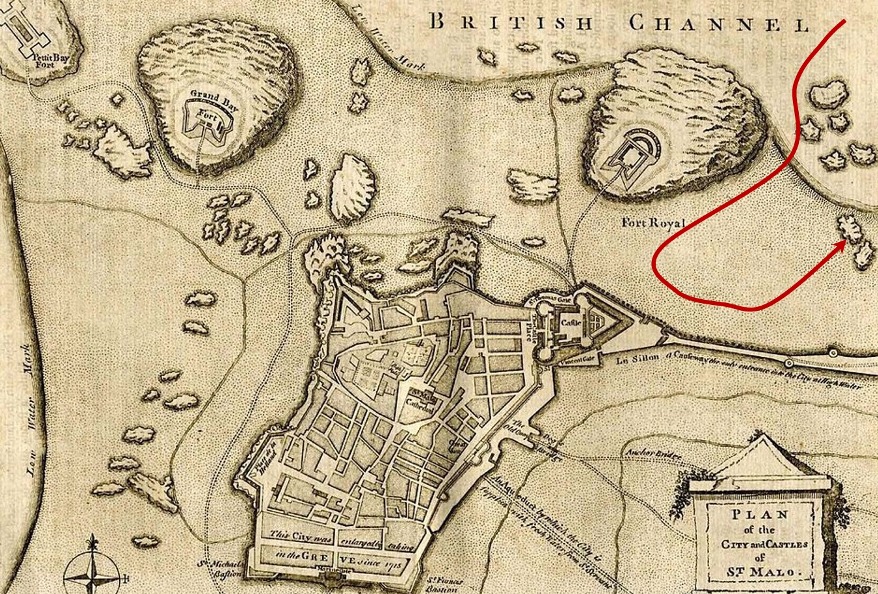
Path of the
Infernal
Machine
showing the
impact of
the change
in wind.
French
historians
believe it
was much
further from
the Saint
Malo and
became
ground on
what is
called les
Pierres aux
Anglais (see
other map).
This
distance
seems too
far to hurl
the ship's
heavy
capstan into
the city.
Then hell
opened up.
The ship
went up in a
deafening
explosion
that shook
Saint-Malo
like an
earthquake.
Roofs were
blown off
houses, the
protecting
sea wall of
the Citadel
collapsed,
the wind
vanes of
nearby
windmills
were ripped
off, and the
concussion
“broke all
the glass,
china, and
earthenware
for three
leagues
round.”
Projectiles
rained down
all about.
Hundreds of
bombs and
grenades
continually
exploded
sending the
French
population
into a
panic.
Flaming
carcasses
fell from
the sky in
every
direction.
Miraculously
part of the
ship
survived due
probably to
wet
gunpowder in
that part of
the haul.
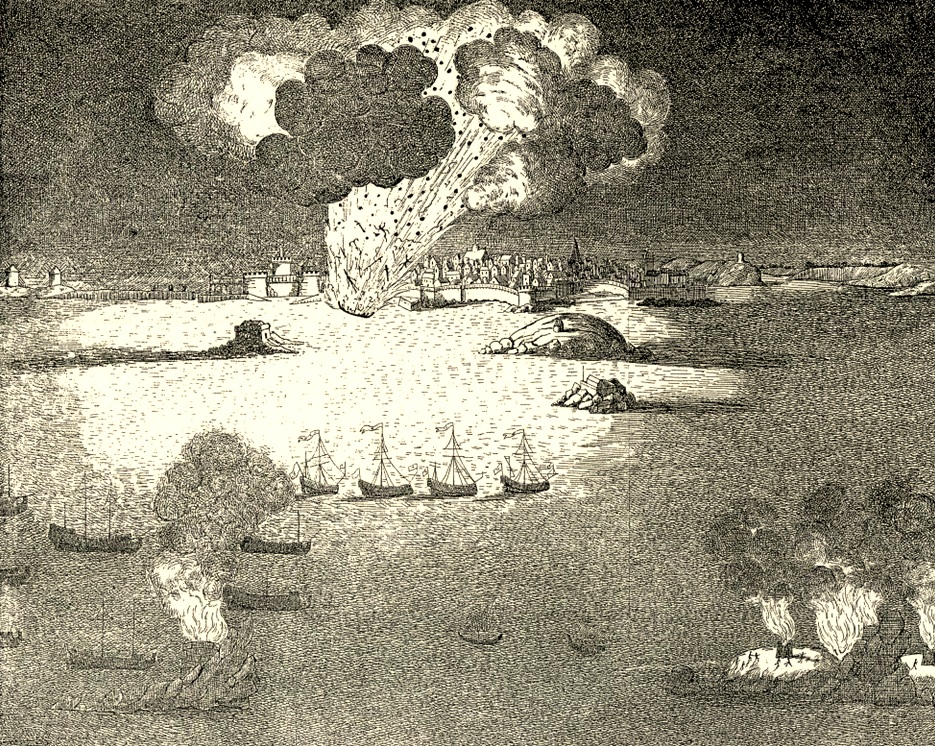
The Infernal
Machine
explodes
(published
1694).
Island
buildings
burn in the
foreground.
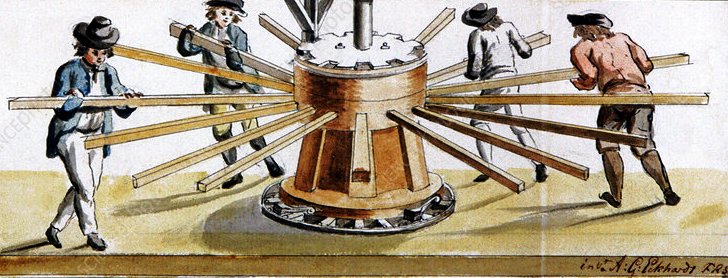
Ship's
Capstan
worked by
sailors
(published
1700). The
two-thousand-pound
capstan of
the
Infernal
landed in
the Saint
Malo's
square
destroying a
house.
While it was
an
incredible
spectacle
causing
substantial
property
damage and
striking
terror deep
into the
hearts of
the people
of Saint
Malo, the
infernal
machine had
failed. Saint
Malo was
damaged but
was still
intact.
Possibly
broken-hearted
Thomas
Phillips
would fall
ill and die
three days
later.
The only
death noted
by the
French was a
cat. “Rue
du Chat-qui-Danse”
or street of
the Dancing
Cat in
Saint-Malo
was named
after the
unfortunate
feline as a
mockery of
the English
attempt to
destroy
their
city. But
behind the
bravado was
a deep fear
of this new
weapon.
French ports
scrambled
for a
solution to
protect
themselves
from
destruction.
Captain
Benbow was
not finished
with the
infernal
machines and
two more
were ready
and a new
attack was
made, this
time on
Dieppe.
However,
French had
adapted by
blocking the
harbour with
sunken
vessels and
the infernal
machines had
little
effect.
When the war
ended in
1697,
infernal
machines
were
abandoned.
It would be
over a
hundred
years before
an infernal
machine
would be
used to try
and blow up
another
pirate nest.
POSTSCRIPT
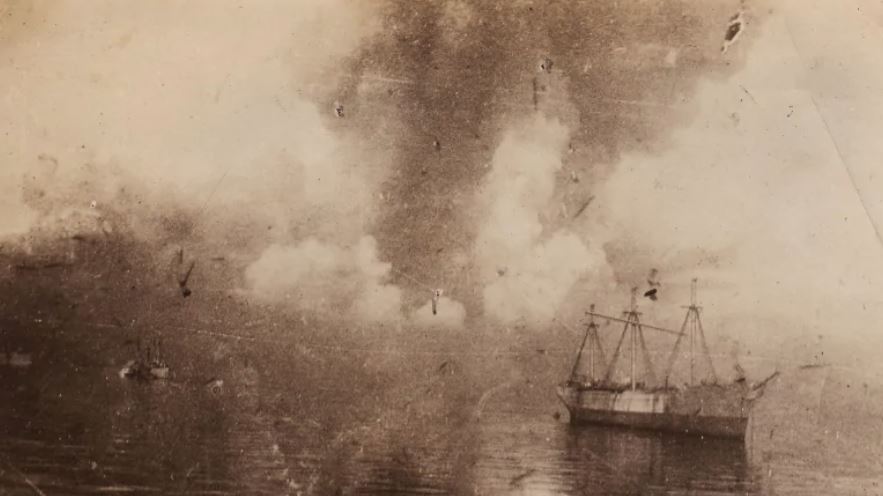
Debris rains
down from
the Halifax
explosion.
On December
6th 1917, a
French cargo
ship filled
with high
explosives
collided
with another
vessel in
the harbour
of Halifax,
Nova
Scotia. The
dangerous
cargo
ignited and
the ship
exploded.
All
structures
in the city
for half a
mile were
levelled,
killing 2000
people and
wounding
9000
others. The
concussion
wave snapped
trees and a
resulting
tsunami wave
beached
ships and
washed away
a Mi’kmaq
village.
Parts of the
French ship
were found
miles away
from the
explosion.
Twenty
thousand
people were
left
homeless
when a
winter
blizzard hit
the day
after.
This
accidental
infernal
machine
shows the
damage Saint
Malo could
have faced
if the wind
had not
suddenly
changed on
November
19th, 1693.
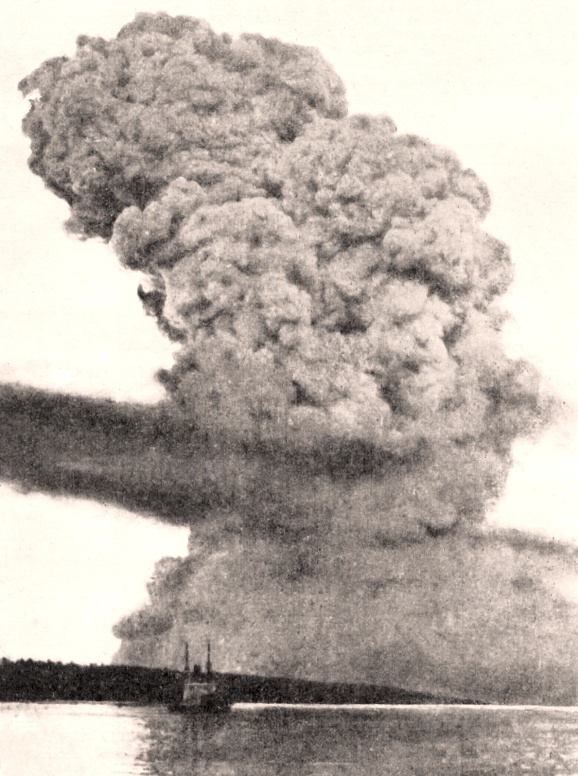
The cloud
from the
Halifax
explosion